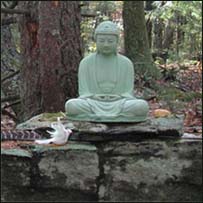|
|
 |
Please support Dharma Seed with a 2025 year-end gift.
Your donations allow us to offer these teachings online to all.

|

|

|
The greatest gift is the
gift of the teachings
|
|

|
| |
|
Dharma Talks
|
2020-02-07
Q&A
52:06
|
|
Ajahn Sucitto
|
|
|
Can non-monastics in the west reach enlightenment? Attachment in relationships; How to encourage care for the environment; Qualities that free us from world of senses; Freedom from rage resulting from abusive relationships; Compassionate response to racist remarks
|
|
Dharmagiri
:
Firm Center, Open Heart
|
|
|
2020-02-06
Mindfulness of Breathing
65:12
|
|
Ajahn Sucitto
|
|
|
Rather than being about the inhalation and exhalation of breath, mindfulness of breathing is about soothing the life force energy. As energy settles in the body, many disruptive emotive tendencies are cleared, leaving the heart available to meet experience in a balanced and sensitive way.
|
|
Dharmagiri
:
Firm Center, Open Heart
|
|
|
2020-02-06
Kamma and Saṇkhāra
46:33
|
|
Ajahn Sucitto
|
|
|
We might experience running down familiar emotional tracks (saṇkhāra). Tracks get laid down by the repeated and habitual reactions to contact (kamma). To clear disturbing and negative tracks, widen attention and check the habitual impulse. The mind naturally seeks harmony and balance. Listen deeply for its response.
|
|
Dharmagiri
:
Firm Center, Open Heart
|
|
|
2020-02-06
3 Channels for Energy
29:57
|
|
Ajahn Sucitto
|
|
|
There is a 3-fold system through which energy operates: bodily, conceptual and emotive. As we practice to resolve and release negative energies, we need resources. Bringing together the 3 aspects of body, mind and heart provide a way to open channels to drain and release unresolved energies.
|
|
Dharmagiri
:
Firm Center, Open Heart
|
|
|
2020-02-05
Embodied Presence (Part 2) - Planting our Roots in the Universe
48:22
|
|
Tara Brach
|
|
|
In describing our human predicament and dis-ease, D.H. Lawrence says we are like a great tree with our roots in the air. We need to replant ourselves—in our bodies, hearts and spirit. These two talks are guides to replanting ourselves. In Part 1, we explore how we are so often dissociated from the life of our body, and the pathways home. Part 2 looks at the challenges of pain, fear and trauma, and how we can gradually and skillfully reconnect with a wholeness of being.
|
|
Insight Meditation Community of Washington DC
|
|
|
|
|